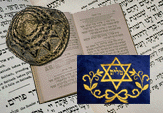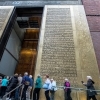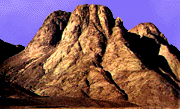Jebel Musa, Arabic for "Mountain of Moses" at the tip of the southern Sinai peninsula has been tradition for many Christian pilgrims since the 4th century AD.
'The Giving of the Law'
 hen the Israelites arrived at Mount Sinai, they encamped on the plain that stretches before it. Sinai must have been a
tremendous sight. The mountain has been identified by some as the mountain now
known as Jebel Musa ( about 6,000 feet high) but this is speculation. This
momentous occasion was one of the most important periods in the entire history of
the Jewish people for here they received the revelation of God's law and the way
of approach to him in the sacred tabernacle.
hen the Israelites arrived at Mount Sinai, they encamped on the plain that stretches before it. Sinai must have been a
tremendous sight. The mountain has been identified by some as the mountain now
known as Jebel Musa ( about 6,000 feet high) but this is speculation. This
momentous occasion was one of the most important periods in the entire history of
the Jewish people for here they received the revelation of God's law and the way
of approach to him in the sacred tabernacle.
![]()

Jewish Tradition
The Midrash says, "If Torah had been given in the land of Israel, Israel might have said to the nations of the world: 'you have no share in it.' Therefore the Torah was given in the wilderness, ie., in public for all to see; and everyone who wishes to receive it let him come and receive it" [Mekhilta]
![]()
They were about to meet their God. The Lord required two days of preparation on the part of the congregation so they would realize who was about to speak to them and that there must be a period of consecration preceding the sound of his voice. They had to be cleansed and all their clothes had to be washed. They even had to abstain form sex with their wives as their hearts and minds were prepared to hear God speak.
Moses drew a boundary at the foot of the mountain beyond which no person or cattle might pass or the penalty would be death. And when the third day came there were visible and audible signs coming from the mountain which caused fear and trembling in the camp.
Exod 19:16-18
Then it came to pass on the third day, in the morning, that there were thunderings and lightnings, and a thick cloud on the mountain; and the sound of the trumpet was very loud, so that all the people who were in the camp trembled. And Moses brought the people out of the camp to meet with God, and they stood at the foot of the mountain. Now Mount Sinai was completely in smoke, because the LORD descended upon it in fire. Its smoke ascended like the smoke of a furnace, and the whole mountain quaked greatly. And when the blast of the trumpet sounded long and became louder and louder, Moses spoke, and God answered him by voice. Then the LORD came down upon Mount Sinai, on the top of the mountain. And the LORD called Moses to the top of the mountain, and Moses went up.
Then God spoke. He spoke not only to his servant Moses as had happened previously, but to the whole congregation (Ex 20:1,19; Deut. 5:4, 22). In place of the trumpet the people heard the very words of the Lord, although they did not see Him. What they heard was the Decalogue or Ten Words, which we refer to now as the Ten Commandments. One after another, in the most awe-inspiring manner, God spoke His Ten Commandments.

Jewish Tradition
Ancient Jewish sages taught that God spoke the Ten Words in the open desert and declared it in the tongue of all nations. This was because the Commandments were not made for Israel alone, but represent a summary of human duties binding upon all men.
![]()
Nevertheless, by the time God finished speaking the people were so terrified that they begged Moses to intervene and communicate God's words to them instead. The voice of God made them fear death, and so they asked Moses to go forward into the darkness and to speak with God.
Moses went up into the mountain for 40 days. What Moses then received from God were the laws and the covenant enacted between God and his people. The record of these laws is contained in more than three chapters of the Bible (Ex 20:22-24:4). They cover laws relating to the altar, slaves, murder, civil offences, property rights, social duties, ethics, and many others.
![]()

Jewish Tradition
When the Jews left Egypt they were told that 7 weeks later they would be receiving the Law (Heb. Torah) at Sinai. God would lift the mountain over their heads, symbolic of a Jewish wedding canopy (Heb. Chuppah) to convey the imagery that God is truly married to His people. The Jews to this day still count the 49 days from Passover (Pentecost) to Pentecost (Shavuot) and it is called the days of Sephirah. Sephirah comes from two Hebrew words, Sephir (Book) and Yah (The Name of God).
When Moses returned to the congregation he recounted to them all the words of the Lord and the various ordinances and so they all replied:
Exod 24:3 ...."All the words which the LORD has said we will do."
The next day was one of the most important in their history because they legalized a covenant with God. This has been singled out as the day on which "these Hebrew slaves became a nation." They had received a divine revelation and they responded to it by entering into the binding covenant that God offered them.
The Biblical definition for Covenant (Testament) is "a binding agreement between two parties." The Hebrew word for covenant is b'rit and actually means "to cut the covenant." It was cut by the shedding of blood and the walking between the two pieces of flesh (Gen 15). A b'rit could not be broken. When you enter into a covenant you make a solemn promise of love and protection to one another.
A Covenant is a binding agreement between two or more persons and Scripture mentions several made between man and man, such as Jacob and Laban, and David and Jonathan. But the really important covenant was that made between God and man. That kind of covenant was unlike a human agreement in which the two parties approached each other on an equal level. In the divine covenant God, being the only one who could truly fulfill the Covenant, reached down to man as a total act of grace and made the Covenant binding because His Word is a sworn oath.
The fact that God established a formal covenant with the children of Israel immediately after their escape from Egypt was of great significance. They were a weak and demoralized people who had formerly been slaves but God offered to make them into a powerful theocracy (a nation with God as the invisible King). On the day the covenant was legalized, Moses built a stone altar at the foot of the mountain and erected twelve pillars, one for each of the tribes of Israel. Sacrifices were made and half the blood of the animals was applied to the altar of the LORD. This is the first record on a national basis of the slaughtering of animals.
After the sacrifice had been made Moses publicly read the entire book of the Covenant in the hearing of the people. This reading of the whole Law was also required to be performed publicly every seven years at the Feast of Booths. Once again they gladly gave their response saying,
Exod 24:7 And they said, "All that the LORD has said we will do, and be obedient."
God made the Covenant with them knowing full well that they would break their promise. But again the Covenant rested not on their performance but entirely on the integrity of God. Moses then sprinkled the people:
Exod 24:8 And Moses took the blood, sprinkled it on the people, and said, "This is the blood of the covenant which the LORD has made with you according to all these words."
After ascending the mountain Moses remained in the divine presence for forty days while new revelations were being given to him. The record of these forty days alone with God covers seven chapters of the Book of Exodus (25-31). Throughout this period God gave Moses instruction on how men should approach him. And it is during this revelation that we first come across the word 'tabernacle'- a word that was to appear well over four hundred times in the Bible.
Vash'kanti - mikdash - li - v'assoo - b'tocham
"And let them make Me a sanctuary, that I may dwell among them" (may be in them).
But we will get to that in a minute. Next we will look at the rebellion.
Copyright ? 1998 The Bible Knowledge AcceleratorRead The Bible
- 1599 Geneva Bible (GNV)
- 21st Century King James Version (KJ21)
- American Standard Version (ASV)
- Amplified Bible (AMP)
- Amplified Bible, Classic Edition (AMPC)
- Authorized (King James) Version (AKJV)
- BRG Bible (BRG)
- Christian Standard Bible (CSB)
- Common English Bible (CEB)
- Complete Jewish Bible (CJB)
- Contemporary English Version (CEV)
- Darby Translation (DARBY)
- Disciples’ Literal New Testament (DLNT)
- Douay-Rheims 1899 American Edition (DRA)
- Easy-to-Read Version (ERV)
- English Standard Version (ESV)
- English Standard Version Anglicised (ESVUK)
- Evangelical Heritage Version (EHV)
- Expanded Bible (EXB)
- GOD’S WORD Translation (GW)
- Good News Translation (GNT)
- Holman Christian Standard Bible (HCSB)
- International Children’s Bible (ICB)
- International Standard Version (ISV)
- J.B. Phillips New Testament (PHILLIPS)
- Jubilee Bible 2000 (JUB)
- King James Version (KJV)
- Lexham English Bible (LEB)
- Living Bible (TLB)
- Modern English Version (MEV)
- Mounce Reverse Interlinear New Testament (MOUNCE)
- Names of God Bible (NOG)
- New American Bible (Revised Edition) (NABRE)
- New American Standard Bible (NASB)
- New American Standard Bible 1995 (NASB1995)
- New Catholic Bible (NCB)
- New Century Version (NCV)
- New English Translation (NET)
- New International Reader's Version (NIRV)
- New International Version - UK (NIVUK)
- New International Version (NIV)
- New King James Version (NKJV)
- New Life Version (NLV)
- New Living Translation (NLT)
- New Matthew Bible (NMB)
- New Revised Standard Version (NRSV)
- New Revised Standard Version Catholic Edition (NRSVCE)
- New Revised Standard Version, Anglicised (NRSVA)
- New Revised Standard Version, Anglicised Catholic Edition (NRSVACE)
- New Testament for Everyone (NTE)
- Orthodox Jewish Bible (OJB)
- Revised Geneva Translation (RGT)
- Revised Standard Version (RSV)
- Revised Standard Version Catholic Edition (RSVCE)
- The Message (MSG)
- The Voice (VOICE)
- Tree of Life Version (TLV)
- World English Bible (WEB)
- Worldwide English (New Testament) (WE)
- Wycliffe Bible (WYC)
- Young's Literal Translation (YLT)
Table of Contents
Main Menu
- Ancient Assyrian Social Structure
- Ancient Babylonia
- Ancient Canaan During the Time of Joshua
- Ancient History Timeline
- Ancient Oil Lamps
- Antonia Fortress
- Archaeology of Ancient Assyria
- Assyria and Bible Prophecy
- Augustus Caesar
- Background Bible Study
- Bible
- Biblical Geography
- Fallen Empires - Archaeological Discoveries and the Bible
- First Century Jerusalem
- Glossary of Latin Words
- Herod Agrippa I
- Herod Antipas
- Herod the Great
- Herod's Temple
- High Priest's in New Testament Times
- Jewish Literature in New Testament Times
- Library collection
- Map of David's Kingdom
- Map of the Divided Kingdom - Israel and Judah
- Map of the Ministry of Jesus
- Matthew Henry Bible Commentary
- Messianic Prophecy
- Nero Caesar Emperor
- Online Bible Maps
- Paul's First Missionary Journey
- Paul's Second Missionary Journey
- Paul's Third Missionary Journey
- Pontius Pilate
- Questions About the Ancient World
- Tabernacle of Ancient Israel
- Tax Collectors in New Testament Times
- The Babylonian Captivity
- The Black Obelisk of Shalmaneser
- The Books of the New Testament
- The Court of the Gentiles
- The Court of the Women in the Temple
- The Destruction of Israel
- The Fall of Judah with Map
- The History Of Rome
- The Incredible Bible
- The Jewish Calendar in Ancient Hebrew History
- The Life of Jesus in Chronological Order
- The Life of Jesus in Harmony
- The Names of God
- The New Testament
- The Old Testament
- The Passion of the Christ
- The Pharisees
- The Sacred Year of Israel in New Testament Times
- The Samaritans
- The Scribes
Ancient Questions
- Why Do the Huldah Gates Appear Different in Ancient Replicas and Modern Photos?
- What Is the Origin of the Japanese and Chinese Peoples? A Biblical Perspective
- How did the ancient Greeks and Romans practice medicine and treat illnesses?
- What were the major contributions of ancient Babylon to mathematics and astronomy?
- How did the ancient Persians create and administer their vast empire?
- What were the cultural and artistic achievements of ancient India, particularly during the Gupta Empire?
- How did ancient civilizations like the Incas and Aztecs build their remarkable cities and structures?
- What were the major trade routes and trading practices of the ancient world?
- What was the role of slavery in ancient societies like Rome and Greece?
- How did the ancient Mayans develop their sophisticated calendar system?
Bible Study Questions
- Why Do Christians Celebrate Christmas?
- How Many Chapters Are There in the Bible?
- The Five Key Visions in the New Testament
- The 400-Year Prophecy: Unpacking Genesis 15 and the Journey of a People
- The Authorized (King James) Version (AKJV): Historical Significance, Translation Methodology, and Lasting Impact
- Exploring the English Standard Version (ESV): Its Aspects, Comparisons, Impact on Biblical Studies, and Church Use
- A Detailed Historical Analysis of Language Updates in the KJ21: Comparison with Other Versions
- A Detailed Historical Analysis of the American Standard Version (ASV): Comparison to the King James Version, Influence on Later Translations, and Evaluation of Strengths and Weaknesses
- A Detailed Historical Analysis of Amplifications in the Amplified Bible (AMP) and Its Comparison to Other Bible Translations
- Detailed Historical Analysis of the Amplified Bible Classic Edition (AMPC): Examples of Amplifications and Comparative Analysis with Other Bible Translations
About
Welcome to Free Bible: Unearthing the Past, Illuminating the Present! Step into a world where ancient history and biblical narratives intertwine, inviting you to explore the rich tapestry of human civilization.
Discover the captivating stories of forgotten empires, delve into the customs and cultures of our ancestors, and witness the remarkable findings unearthed by dedicated archaeologists.
Immerse yourself in a treasure trove of knowledge, where the past comes alive and illuminates our understanding of the present.
Join us on this extraordinary journey through time, where curiosity is rewarded and ancient mysteries await your exploration.
Recent posts
-

The Role of AI in Cryptocurrency Trading and Blockchain Security
Artificial Intelligence (AI) is rapidly reworking industries, and the cryptocurrency sector is not any exception. From enhancing trading techniques to... -

The impact of IP address on LinkedIn traffic
IP address has a serious impact on LinkedIn traffic. Before you start working with the site, you should clarify the specifics of this influence and ho... -

The Bible in Museums: Where to See Ancient Scripture Today
The Bible, as one of the most influential books in human history, has shaped not only religious beliefs but also the course of civilization. Its stori... -

How AI is Revolutionizing 2025: Latest Innovations and Industry Applications
Artificial Intelligence (AI) has turn out to be one of the maximum transformative technologies of the twenty first century. As we flow via 2025, AI ke... -

AI-Powered Innovation: How Businesses Are Leveraging AI for Growth
Artificial Intelligence (AI) is no longer a futuristic concept however a fundamental driving force of innovation in these days’s commercial enterpri...

